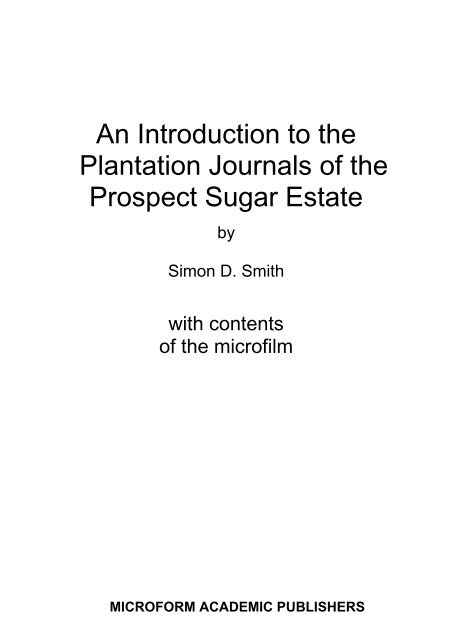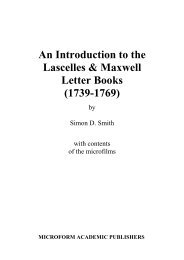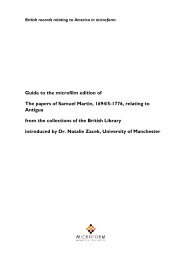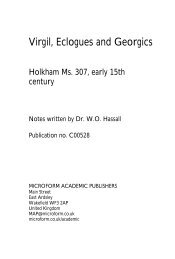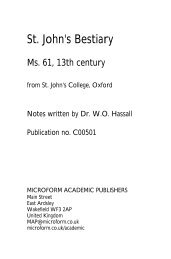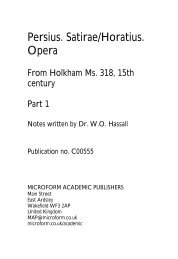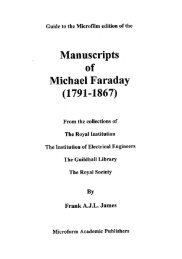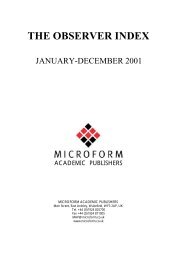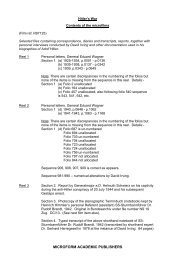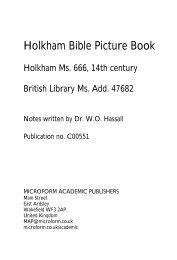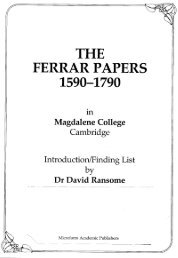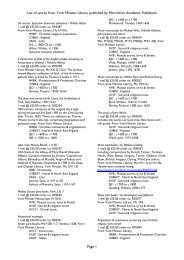An introduction to the plantation journals of the Prospect ... - Microform
An introduction to the plantation journals of the Prospect ... - Microform
An introduction to the plantation journals of the Prospect ... - Microform
You also want an ePaper? Increase the reach of your titles
YUMPU automatically turns print PDFs into web optimized ePapers that Google loves.
<strong>An</strong> Introduction <strong>to</strong> <strong>the</strong><br />
Plantation Journals <strong>of</strong> <strong>the</strong><br />
<strong>Prospect</strong> Sugar Estate<br />
by<br />
Simon D. Smith<br />
with contents<br />
<strong>of</strong> <strong>the</strong> micr<strong>of</strong>ilm<br />
MICROFORM ACADEMIC PUBLISHERS
<strong>An</strong> Introduction <strong>to</strong> <strong>the</strong><br />
Plantation Journals <strong>of</strong> <strong>the</strong><br />
<strong>Prospect</strong> Sugar Estate<br />
by<br />
Simon D. Smith<br />
University <strong>of</strong> York<br />
with contents<br />
<strong>of</strong> <strong>the</strong> micr<strong>of</strong>ilm
© Simon D. Smith, 2004<br />
ISBN 10: 1-85117-074-X<br />
ISBN 13: 978-1-85117-074-6<br />
Published by:<br />
Micr<strong>of</strong>orm Academic Publishers<br />
Main Street, East Ardsley<br />
Wakefield, West Yorkshire WF3 2AP<br />
United Kingdom<br />
Tel: +44 (0)1925 825700<br />
Fax: +44 (0)1924 871005<br />
Email: map@micr<strong>of</strong>orm.co.uk<br />
Web: www.micr<strong>of</strong>orm.co.uk/academic
<strong>An</strong> Introduction <strong>to</strong> <strong>the</strong> Plantation Journals <strong>of</strong><br />
<strong>Prospect</strong> Sugar Estate, Jamaica<br />
<strong>Prospect</strong> is <strong>the</strong> name <strong>of</strong> a sugar estate that once operated in <strong>the</strong> parish <strong>of</strong><br />
Portland in <strong>the</strong> north-eastern corner <strong>of</strong> Jamaica. 1 For five decades prior <strong>to</strong> <strong>the</strong><br />
abolition <strong>of</strong> slavery in 1834, this <strong>plantation</strong> was <strong>the</strong> home and workplace <strong>of</strong> a<br />
population numbering up <strong>to</strong> 162 enslaved men, women, and children. 2 Approximately<br />
half <strong>of</strong> <strong>Prospect</strong>’s inhabitants were born in<strong>to</strong> slavery, most <strong>of</strong> <strong>the</strong>m on <strong>the</strong> property<br />
itself; <strong>the</strong> o<strong>the</strong>rs were forcibly shipped <strong>to</strong> Jamaica from Africa in order <strong>to</strong> replenish a<br />
labour system unable <strong>to</strong> reproduce itself naturally. Condemned <strong>to</strong> a lifetime <strong>of</strong> <strong>to</strong>il,<br />
<strong>the</strong> majority <strong>of</strong> <strong>the</strong> enslaved worked in <strong>the</strong> cane fields, boiling house, and crushing<br />
mill <strong>to</strong> produce rum and sugar for <strong>the</strong> benefit <strong>of</strong> absentee owners in Britain.<br />
Much remains <strong>to</strong> be discovered about <strong>the</strong> inhabitants <strong>of</strong> this previously<br />
unstudied sugar estate. This <strong>introduction</strong> is based on a general survey <strong>of</strong> a batch <strong>of</strong><br />
manuscripts preserved in <strong>the</strong> Barclays Group Archive, Manchester. 3 The collection<br />
primarily consists <strong>of</strong> eight volumes describing <strong>the</strong> daily operation <strong>of</strong> <strong>the</strong> <strong>plantation</strong><br />
between 1784 and 1793. 4 Some insights in<strong>to</strong> <strong>the</strong> later his<strong>to</strong>ry <strong>of</strong> <strong>Prospect</strong> (from 1817<br />
until 1834) have also been gleaned from <strong>the</strong> slave registration and compensation<br />
commission records preserved in <strong>the</strong> National Archives in London. 5<br />
Provenance is <strong>the</strong> first issue that must be addressed when encountering a<br />
new documentary hoard. The precise circumstances under which <strong>the</strong> manuscripts<br />
came in<strong>to</strong> <strong>the</strong> possession <strong>of</strong> Barclays are not known, but it is clear that <strong>the</strong> Bank has<br />
provided <strong>the</strong> materials with a resting place for a great many years. In Mat<strong>the</strong>ws and<br />
Tuke’s 1926 his<strong>to</strong>ry <strong>of</strong> Barclays, <strong>the</strong> documents are mentioned briefly:<br />
It must not be inferred from this catalogue <strong>of</strong> famous names that <strong>the</strong> Bank did<br />
business only with people at one end <strong>of</strong> <strong>the</strong> social scale; <strong>the</strong> majority were not<br />
notable, like many who have been mentioned, nor even no<strong>to</strong>rious, like poor<br />
Comte d’Orsay; but one at least has left behind him some interesting books and<br />
papers. This gentleman, who was one <strong>of</strong> <strong>the</strong> earliest cus<strong>to</strong>mers, was <strong>the</strong> owner<br />
<strong>of</strong> a <strong>plantation</strong>, and as such was an employer <strong>of</strong> slave labour. Amongst his<br />
papers is his s<strong>to</strong>ck book, <strong>the</strong> first page <strong>of</strong> which contains an account <strong>of</strong> <strong>the</strong><br />
slaves for <strong>the</strong> year 1784. The fact that <strong>the</strong> succeeding pages deal in a similar<br />
way with horses, cattle and implements shows that <strong>the</strong> slaves were looked upon<br />
merely as part <strong>of</strong> <strong>the</strong> lives<strong>to</strong>ck on <strong>the</strong> property. 6<br />
Mat<strong>the</strong>ws and Tuke discreetly omitted <strong>to</strong> name <strong>the</strong> owner <strong>of</strong> <strong>Prospect</strong> Estate,<br />
referring <strong>to</strong> him only as a ‘gentleman’, but <strong>the</strong>y did suggest a route by which <strong>the</strong><br />
papers were acquired by <strong>the</strong> Bank; namely, as part <strong>of</strong> a miscellaneous deposit by<br />
one <strong>of</strong> its earliest cus<strong>to</strong>mers. The owner <strong>of</strong> <strong>Prospect</strong> can now be revealed as <strong>the</strong><br />
London and Kings<strong>to</strong>n merchant, Stephen Attlay, who in an account current <strong>of</strong> 1785-6<br />
was accorded <strong>the</strong> title <strong>of</strong> ‘Esquire’. Over <strong>the</strong> years, many strange items have been<br />
left in safe deposit boxes across <strong>the</strong> world by banking clients who, for a variety <strong>of</strong><br />
reasons, have never returned <strong>to</strong> claim <strong>the</strong>m. Do <strong>the</strong> <strong>Prospect</strong> papers fall in<strong>to</strong> <strong>the</strong><br />
category <strong>of</strong> misplaced personal effects?<br />
1
Prior <strong>to</strong> <strong>the</strong>ir relocation <strong>to</strong> <strong>the</strong> Manchester archive, <strong>the</strong> manuscripts were<br />
s<strong>to</strong>red in <strong>the</strong> strong room <strong>of</strong> <strong>the</strong> Pall Mall branch <strong>of</strong> Barclays in London, along with<br />
o<strong>the</strong>r old banking records. <strong>An</strong> retired employee <strong>of</strong> <strong>the</strong> Bank, Mr. A.J. Tubb, recalled<br />
in 2001 how, early in his career, he was shown <strong>the</strong> ledgers belonging <strong>to</strong> a lateeighteenth<br />
century West Indian <strong>plantation</strong>. Mr. Tubb remembered being taken aback,<br />
as a young man, by <strong>the</strong> fact that <strong>the</strong> <strong>journals</strong> ‘were kept in exactly <strong>the</strong> same way as<br />
an account ledger’, as slave purchases or births were added <strong>to</strong> <strong>the</strong> credit side, whilst<br />
‘when a slave died or escaped, a debit was recorded.’ 7<br />
Barclays' Pall Mall branch had begun life in 1782 as <strong>the</strong> home <strong>of</strong> a separate<br />
and independent banking partnership between Griffin Ransom, William Morland, and<br />
Thomas Hammersley. The bank became a branch <strong>of</strong> Barclays in 1888 when <strong>the</strong>ir<br />
successors, Ransom, Bouverie and Co., merged with Barclay, Bevan, Trit<strong>to</strong>n and<br />
Co. <strong>of</strong> Lombard Street. 8 The earliest surviving ledgers from <strong>the</strong> banking house<br />
founded by this trio reveal that Stephen Attlay’s son, Stephen Oakeley Attlay Sr.,<br />
held an account with <strong>the</strong> bank in 1802 and 1803. He had probably also been a<br />
cus<strong>to</strong>mer for some years prior <strong>to</strong> this. 9 Although <strong>the</strong> Attlay family were clients,<br />
however, it does not follow that <strong>the</strong> records survived because <strong>the</strong>y were deposited<br />
<strong>the</strong>re for safe keeping. <strong>An</strong> examination <strong>of</strong> <strong>the</strong> his<strong>to</strong>ry <strong>of</strong> Oakeley Attlay family<br />
suggests that <strong>the</strong> manuscripts survived for different reasons.<br />
Some <strong>of</strong> <strong>the</strong> earliest private British banks can trace <strong>the</strong>ir foundation <strong>to</strong><br />
eighteenth-century merchant partnerships. Indeed, a number <strong>of</strong> London merchants<br />
acted as <strong>the</strong> commission agents <strong>of</strong> <strong>plantation</strong> owners who ei<strong>the</strong>r resided in <strong>the</strong><br />
colonies or who were absentee owners in Britain. The services provided by <strong>the</strong><br />
commission houses included account current facilities, overdrafts, and, in some<br />
cases, longer term credit secured by mortgages. There is evidence that during <strong>the</strong><br />
eighteenth century <strong>the</strong> relationship between bankers and merchants grew<br />
increasingly close in <strong>the</strong> financing <strong>of</strong> <strong>the</strong> sugar trade. 10<br />
To moni<strong>to</strong>r large-scale agricultural enterprises, situated thousands <strong>of</strong> miles<br />
away, <strong>the</strong> managers and overseers <strong>of</strong> West Indian estates were instructed <strong>to</strong> draw<br />
up detailed records <strong>of</strong> <strong>the</strong> day-<strong>to</strong>-day operation <strong>of</strong> <strong>plantation</strong>s under <strong>the</strong>ir care. The<br />
seven <strong>journals</strong> and <strong>the</strong> <strong>plantation</strong> book that comprise <strong>the</strong> bulk <strong>of</strong> <strong>the</strong> <strong>Prospect</strong> Estate<br />
collection were compiled for this purpose. His<strong>to</strong>rians rarely enjoy <strong>the</strong> luxury <strong>of</strong><br />
studying a complete documentary example <strong>of</strong> a West India business relationship. In<br />
some instances, an extended run <strong>of</strong> correspondence survives between <strong>the</strong> merchant<br />
and <strong>the</strong> owners and managers <strong>of</strong> a sugar estate; in o<strong>the</strong>r cases, such as <strong>Prospect</strong>, it<br />
is just <strong>the</strong> <strong>journals</strong> that have found <strong>the</strong>ir way in<strong>to</strong> an archive. 11<br />
Significantly, Stephen Oakeley Attlay Sr.’s account with Ransom, Morland,<br />
and Hammersley does not make any explicit reference <strong>to</strong> <strong>Prospect</strong>. A sample <strong>of</strong><br />
Ransom, Morland, and Hammersely’s o<strong>the</strong>r cus<strong>to</strong>mer accounts also unear<strong>the</strong>d no<br />
evidence that <strong>the</strong> firm combined banking with commission trading in <strong>plantation</strong><br />
produce. The failure <strong>of</strong> <strong>the</strong> Attlay’s bank account with Ransom and partners <strong>to</strong><br />
mention <strong>the</strong> sugar estate contrasts with an account statement (dated 1785-6)<br />
prepared for Stephen Attlay by <strong>the</strong> London merchants William and Thomas Bond.<br />
The Bonds’ account clearly records <strong>the</strong> receipt <strong>of</strong> sugar from <strong>Prospect</strong> and <strong>the</strong><br />
2
shipment <strong>of</strong> <strong>plantation</strong> s<strong>to</strong>res <strong>to</strong> <strong>the</strong> estate. 12 Similar entries would also have<br />
appeared in <strong>the</strong> ledgers <strong>of</strong> Ransom, Moreley, and Hammersley if this concern had<br />
likewise been involved in <strong>the</strong> <strong>plantation</strong> trades. Moreover, <strong>the</strong> Bonds appear <strong>to</strong> have<br />
handled <strong>Prospect</strong>’s account only as a temporary expedient owing <strong>to</strong> <strong>the</strong> illness and<br />
subsequent death <strong>of</strong> Attlay. In his will, dated 9 April 1786, Attlay bequea<strong>the</strong>d <strong>the</strong><br />
Bond bro<strong>the</strong>rs money <strong>to</strong> buy mourning rings as a gesture <strong>of</strong> gratitude for <strong>the</strong> late<br />
services <strong>the</strong>y had rendered him. The account current itself notes that Attlay’s death<br />
occurred shortly afterwards. 13<br />
One <strong>of</strong> <strong>the</strong> bound volumes in <strong>the</strong> <strong>Prospect</strong> archive, entitled <strong>the</strong> ‘<strong>Prospect</strong><br />
Plantation Book’, records cargoes <strong>of</strong> sugar consigned <strong>to</strong> British ports between 1784<br />
and 1791. It is notable that, for <strong>the</strong> first two years spanned by this document, sugar<br />
was despatched addressed <strong>to</strong> Stephen Attlay in his own right, whilst in 1787 Stephen<br />
Oakeley Attlay Sr. <strong>to</strong>ok over receipt <strong>of</strong> <strong>the</strong> cargoes. Unfortunately, for <strong>the</strong> remaining<br />
years, <strong>the</strong> source records only <strong>the</strong> quantity <strong>of</strong> sugar shipped with details <strong>of</strong> <strong>the</strong> vessel<br />
carrying <strong>the</strong> cargo, omitting all reference <strong>to</strong> <strong>the</strong> recipient. A detailed examination <strong>of</strong><br />
<strong>the</strong> Accounts Produce volumes in <strong>the</strong> Jamaica Archives (a record <strong>of</strong> <strong>the</strong> crops<br />
produced on <strong>plantation</strong>s owned by absentees) would perhaps establish whe<strong>the</strong>r<br />
Oakeley Attlay Sr. continued <strong>to</strong> receive sugar, as is conjectured here, or whe<strong>the</strong>r <strong>the</strong><br />
cargoes were consigned <strong>to</strong> commission merchants. 14<br />
The available evidence suggests strongly that, as merchants engaged in <strong>the</strong><br />
West Indian trades, <strong>the</strong> Attlays dispensed with <strong>the</strong> services <strong>of</strong> agents and supervised<br />
<strong>the</strong>ir own business affairs, with Ransom, Morland, and Hammersley acting merely as<br />
<strong>the</strong> family’s bankers. Stephen Attlay is known <strong>to</strong> have held victualling contracts <strong>to</strong><br />
supply troops stationed in Jamaica with provisions during both <strong>the</strong> Seven Years’ War<br />
(1756-63) and <strong>the</strong> War <strong>of</strong> <strong>the</strong> American Revolution (1776-83). 15 He specialised in <strong>the</strong><br />
supply <strong>of</strong> beef and at his death a balance <strong>of</strong> £2,746. 1s. 1d. was still owing from<br />
government commissioners on this account. Involvement in victuals provides an<br />
indication <strong>of</strong> <strong>the</strong> Attlays’ standing as merchants, since contracts <strong>to</strong> provision troops<br />
were generally granted <strong>to</strong> well-financed merchants possessing excellent colonial<br />
connections. 16<br />
Additional information about Attlay’s wealth and his activities as a merchant is<br />
provided in an inven<strong>to</strong>ry <strong>of</strong> Jamaican assets, compiled after his death in December<br />
1786. This document valued <strong>Prospect</strong> Estate at £8,674. 5s. currency (£6,193. 15s.<br />
sterling): an under-estimate <strong>of</strong> its true value since <strong>the</strong> inven<strong>to</strong>ry excluded <strong>the</strong> land<br />
and sugar works, rating only <strong>the</strong> enslaved and moveable property. 17 Interestingly, <strong>the</strong><br />
sugar estate accounted for less than half <strong>of</strong> Attlay’s gross inven<strong>to</strong>ried wealth on <strong>the</strong><br />
island. In addition <strong>to</strong> <strong>Prospect</strong>, he was <strong>the</strong> owner <strong>of</strong> a lives<strong>to</strong>ck pen named Dirty Pit,<br />
which was leased <strong>to</strong> William Patrick Brown (a member <strong>of</strong> Jamaica’s Council) at £980<br />
currency per annum. Alongside <strong>the</strong> 162 slaves at <strong>Prospect</strong>, a fur<strong>the</strong>r 40 enslaved<br />
workers belonging <strong>to</strong> Attlay were rented <strong>to</strong> Brown valued at £2,340 currency. 18<br />
Brown was also a credi<strong>to</strong>r <strong>of</strong> Attlay’s and in 1786 owed him £1,222. 7s. 6d. currency<br />
secured by bond. Six fur<strong>the</strong>r deb<strong>to</strong>rs are listed in <strong>the</strong> inven<strong>to</strong>ry, which details<br />
£1,731.0s.6d. currency <strong>of</strong> loans granted by Attlay on <strong>the</strong> island between 1772 and<br />
1784. In <strong>to</strong>tal, <strong>the</strong>refore, Attlay’ gross assets on Jamaica, exclusive <strong>of</strong> real estate,<br />
amounted <strong>to</strong> £14,947.13s. currency (£10,696 3s. 6d. sterling). 19<br />
3
Stephen Oakeley Attlay Sr., like his fa<strong>the</strong>r, possessed commercial interests.<br />
His account with Ransom, Morland, and Hammersley records a turnover <strong>of</strong> £12,118<br />
sterling between 1802 and 1803, made up principally <strong>of</strong> securities transactions. In<br />
addition <strong>to</strong> s<strong>to</strong>cks and shares, Oakeley Attlay Sr. invested directly in companies. His<br />
name appears, for example, as a direc<strong>to</strong>r <strong>of</strong> <strong>the</strong> Teignmouth and Shaldon Bridge<br />
Company in 1825 and 1827. The extent <strong>of</strong> Oakeley Attlay Sr.’s wealth is suggested<br />
by his draft will <strong>of</strong> 1817, which contemplated leaving his wife an annuity <strong>of</strong> £500 a<br />
year and his daughter a legacy <strong>of</strong> £10,000, in addition <strong>to</strong> bequeathing <strong>Prospect</strong> and<br />
<strong>the</strong> residue <strong>of</strong> his estate <strong>to</strong> his son Stephen Oakeley Attlay Jr. 20<br />
The business activities <strong>of</strong> <strong>the</strong> Attlays indicate that <strong>the</strong> system <strong>of</strong> management<br />
that oversaw production on <strong>Prospect</strong> was a modified version <strong>of</strong> absentee ownership<br />
that excluded reliance on London commission merchants. Regular reports on <strong>the</strong><br />
health and numbers <strong>of</strong> <strong>the</strong> enslaved workforce were sent direct <strong>to</strong> <strong>the</strong> Attlays in<br />
Britain, ra<strong>the</strong>r than <strong>to</strong> intermediaries, along with accounts <strong>of</strong> crop production and<br />
sales. The kernel <strong>of</strong> this information is contained within <strong>the</strong> <strong>plantation</strong>’s surviving<br />
<strong>journals</strong>. On Jamaica itself, <strong>the</strong> daily tasks carried out by <strong>the</strong> enslaved were<br />
supervised by overseers living on <strong>the</strong> property. The names <strong>of</strong> seven different<br />
overseers between 1787 and 1791 are recorded as declaring <strong>the</strong> number <strong>of</strong> slaves<br />
and lives<strong>to</strong>ck <strong>to</strong> <strong>the</strong> parish vestry. 21 Among <strong>the</strong>se seven individuals, <strong>the</strong> name <strong>of</strong><br />
Thomas Oakeley is <strong>of</strong> particular importance since he played a major role in looking<br />
after <strong>the</strong> interests <strong>of</strong> <strong>the</strong> absentee Attlays on Jamaica.<br />
Thomas Oakeley (b.1744) was <strong>the</strong> bro<strong>the</strong>r <strong>of</strong> Stephen Attlay’s wife Parnel<br />
(1735-1815). In 1786, Oakeley was resident in Port <strong>An</strong><strong>to</strong>nio as a merchant, handling<br />
sugar and rum sent from <strong>Prospect</strong> for export. By 1817, an individual named Thomas<br />
Oakeley had become <strong>the</strong> owner <strong>of</strong> two properties in Portland parish that collectively<br />
employed sixty enslaved workers. Three years later, <strong>the</strong> slave registration return<br />
prefaced <strong>the</strong> owner’s name with <strong>the</strong> word ‘Honourable’: a title reserved for members<br />
<strong>of</strong> Jamaica’s Council. The person named was ei<strong>the</strong>r <strong>the</strong> Port <strong>An</strong><strong>to</strong>nio merchant or his<br />
nephew Thomas Oakeley (b.1773), who in 1796 was living on Jamaica under <strong>the</strong><br />
care <strong>of</strong> his uncle, but by 1816 had returned <strong>to</strong> England in order <strong>to</strong> re-marry. 22<br />
Thomas Oakeley senior and junior were both members <strong>of</strong> <strong>the</strong> Snakecr<strong>of</strong>t (later<br />
Bagnall) Oakeleys: a scion <strong>of</strong> <strong>the</strong> gentry Oakeley family <strong>of</strong> Shropshire. 23 The<br />
Snakecr<strong>of</strong>t Oakeleys originated from Bishop’s Castle in Shropshire, where bro<strong>the</strong>r<br />
and sister Parnel and Thomas were both born, but <strong>the</strong> family also possessed land in<br />
Monmouthshire. Parnel Oakeley lived out years <strong>of</strong> widowhood at Lydart House); after<br />
her death, members <strong>of</strong> <strong>the</strong> Oakeleys resided at Lydart and <strong>the</strong> 1851 Cenus provides<br />
an indication <strong>of</strong> <strong>the</strong>ir social status. The head <strong>of</strong> <strong>the</strong> Oakeley household was a<br />
freeholder and farmed 136 acres, while his three sons were occupied as a solici<strong>to</strong>r, a<br />
curate, and an Oxford undergraduate. 24<br />
Sufficient evidence has been identified <strong>to</strong> ascertain that <strong>Prospect</strong> Estates’<br />
owners were British merchants and planters with gentry connections, who managed<br />
<strong>the</strong> <strong>plantation</strong> as absentees largely without recourse <strong>to</strong> agents o<strong>the</strong>r than <strong>the</strong>ir<br />
kinsmen. Yet if <strong>the</strong> Attlays were directly involved in <strong>the</strong> management <strong>of</strong> <strong>Prospect</strong> and<br />
maintained <strong>the</strong>ir own records, by what route did <strong>the</strong> <strong>journals</strong> find <strong>the</strong>ir way in<strong>to</strong> <strong>the</strong><br />
4
Barclays Group Archive? The solution <strong>to</strong> this mystery probably lies in Stephen<br />
Oakeley Attlay Sr.’s response <strong>to</strong> <strong>the</strong> abolition <strong>of</strong> slavery, coupled with <strong>the</strong> decision <strong>of</strong><br />
his son and heir not <strong>to</strong> pursue a business career. In 1834, <strong>the</strong> parliamentary<br />
commissioners charged with compensating slave owners valued <strong>Prospect</strong>’s 141<br />
enslaved workers at £6,420 sterling. Oakeley Attlay Sr. assigned <strong>the</strong> resulting<br />
compensation award <strong>of</strong> £2,809. 19s. 1d. <strong>to</strong> <strong>the</strong> merchant partnership <strong>of</strong> Jegon and<br />
Ru<strong>the</strong>rford, who had granted him a mortgage <strong>of</strong> £5,842. 12s. 9d. At <strong>the</strong> time <strong>of</strong><br />
emancipation, <strong>Prospect</strong> also carried an additional debt <strong>of</strong> £1,000 owed <strong>to</strong> <strong>the</strong><br />
merchants Langmead and Jordan. This second loan was also paid <strong>of</strong>f as part <strong>of</strong> <strong>the</strong><br />
settlement with <strong>the</strong> compensation commission. 25 Though <strong>the</strong> net financial positions<br />
<strong>of</strong> Stephen Attlay and his son at <strong>the</strong> time <strong>of</strong> <strong>the</strong>ir decease cannot be determined, it is<br />
striking that by 1834 <strong>Prospect</strong> had itself become encumbered by debt, in contrast <strong>to</strong><br />
<strong>the</strong> position in 1786 when debts were owed <strong>to</strong> <strong>the</strong> Attlay estate from local planters.<br />
Oakeley Attlay Sr. died in 1839, <strong>the</strong> year following full emancipation on<br />
Jamaica. His son and namesake was <strong>the</strong> Revd. Stephen Oakeley Attlay Jr., vicar <strong>of</strong><br />
St. Stephen’s church, Norwich. 26 Portland had always been marginal land for sugar<br />
cultivation and it was not <strong>to</strong> revive as an agricultural area until <strong>the</strong> banana tree (a<br />
crop better suited <strong>to</strong> <strong>the</strong> region’s relatively high precipitation levels) was introduced.<br />
By <strong>the</strong> end <strong>of</strong> <strong>the</strong> four year period <strong>of</strong> slave ‘apprenticeship’ in 1838, only 112 workers<br />
were left at <strong>Prospect</strong>, signifying that sugar and rum production was in <strong>the</strong> process <strong>of</strong><br />
being run down. 27 It appears probable, <strong>the</strong>refore, that <strong>Prospect</strong> was disposed <strong>of</strong><br />
shortly after <strong>the</strong> death <strong>of</strong> Oakeley Attlay Sr. and that <strong>the</strong> <strong>plantation</strong>’s <strong>journals</strong> were<br />
deposited with Ransom and Company during <strong>the</strong> winding up <strong>of</strong> his estate. If this<br />
hypo<strong>the</strong>sis is accepted, it is likely that <strong>the</strong> bank acted as trustees for <strong>the</strong> Revd.<br />
Oakeley Attlay Jr. and was responsible for administering <strong>the</strong> various legacies<br />
charged on <strong>Prospect</strong> that were assigned along with <strong>the</strong> compensation claim.<br />
There are thus no direct links between Barclays Bank and <strong>the</strong> owners <strong>of</strong><br />
<strong>Prospect</strong> Estate. On Jamaica, Stephen Attlay’s business associates included a<br />
George Barclay (Attlay’s partner in <strong>the</strong> victualling trade during <strong>the</strong> Seven Years’ War<br />
was one George Barclay), whilst <strong>the</strong> list <strong>of</strong> deb<strong>to</strong>rs owing Attlay’s estate money<br />
refers <strong>to</strong> a James Barclay. A <strong>plantation</strong> named Barclay’s was also in operation in<br />
Portland parish in 1804. None <strong>of</strong> <strong>the</strong>se circumstances, however, explain <strong>the</strong><br />
subsequent deposit <strong>of</strong> <strong>Prospect</strong>’s records in <strong>the</strong> Barclays Archive, and <strong>the</strong>re is also<br />
no evidence <strong>to</strong> link any <strong>of</strong> <strong>the</strong>se individuals <strong>to</strong> <strong>the</strong> Bank. Barclays itself grew out <strong>of</strong> a<br />
late 17th century London goldsmith partnership, as did several o<strong>the</strong>rs in <strong>the</strong> decades<br />
after <strong>the</strong> civil war. Sometime later <strong>the</strong> Barclays entered in<strong>to</strong> a marriage and banking<br />
alliance with ano<strong>the</strong>r Quaker family, <strong>the</strong> Gurneys <strong>of</strong> East <strong>An</strong>glia.<br />
<strong>Prospect</strong> Estate represented a last link between <strong>the</strong> Attlays and slavery in <strong>the</strong><br />
Caribbean, but how long had this family connection existed? In 1832, <strong>the</strong> Bridgwater<br />
and Somerset Advertiser recorded <strong>the</strong> marriage <strong>of</strong> <strong>the</strong> ‘Revd. Stephen Oakley Attlay<br />
<strong>of</strong> Teignmouth’ <strong>to</strong> Ca<strong>the</strong>rine Robinson <strong>of</strong> Ilfracombe. As has already been noted,<br />
Attlay’s fa<strong>the</strong>r was a direc<strong>to</strong>r <strong>of</strong> a Bridge Company at Teignmouth. The regional<br />
connection is fur<strong>the</strong>r streng<strong>the</strong>ned by Oakley Attlay Sr.’s draft will <strong>of</strong> 1817, which<br />
names as trustee <strong>the</strong> Revd. Henry Woollcombe <strong>of</strong> <strong>the</strong> nearby community <strong>of</strong> Ashbury.<br />
Indeed, <strong>the</strong> surname ‘Attlay’ may be derived from <strong>the</strong> place name ‘Ha<strong>the</strong>rleigh’,<br />
5
located five miles from Ashbury. A striking feature <strong>of</strong> Ha<strong>the</strong>rleigh’s parish registers is<br />
that in 1604 and 1606 <strong>the</strong>y record <strong>the</strong> baptism <strong>of</strong> two Africans. 28 Outside <strong>of</strong> <strong>the</strong> port<br />
communities <strong>of</strong> Plymouth and Barnstaple (home <strong>to</strong> <strong>the</strong> region’s merchants),<br />
Ha<strong>the</strong>rleigh appears <strong>to</strong> be unique in documenting a cluster <strong>of</strong> black inhabitants in this<br />
region <strong>of</strong> Britain as early as <strong>the</strong> end <strong>of</strong> <strong>the</strong> sixteenth century. The implications <strong>of</strong> this<br />
finding are not clear. One possible inference that might be drawn, however, is that<br />
<strong>the</strong> involvement <strong>of</strong> inhabitants <strong>of</strong> Ha<strong>the</strong>rleigh in transatlantic slavery extended for a<br />
far longer period <strong>of</strong> time that spanned by <strong>the</strong> surviving records <strong>of</strong> <strong>Prospect</strong>.<br />
The parish <strong>of</strong> Portland is <strong>the</strong> smallest in Jamaica, outside <strong>of</strong> Kings<strong>to</strong>n,<br />
occupying an area <strong>of</strong> just 14,000 acres. During <strong>the</strong> period <strong>of</strong> slavery, Port <strong>An</strong><strong>to</strong>nio<br />
formed <strong>the</strong> region’s largest settlement and its commercial hub, providing a maritime<br />
link with <strong>the</strong> outside world. Prior <strong>to</strong> <strong>the</strong> later eighteenth century, Portland was one <strong>of</strong><br />
<strong>the</strong> most isolated and scarcely populated parts <strong>of</strong> Jamaica. A rugged and exposed<br />
coastline discouraged commerce, <strong>the</strong> absence <strong>of</strong> a dry season hindered sugar<br />
cultivation, and <strong>the</strong> geographical barrier <strong>of</strong> <strong>the</strong> Blue Mountains hampered<br />
communications with Spanish Town and Kings<strong>to</strong>n. 29 The development <strong>of</strong> Portland<br />
was fur<strong>the</strong>r discouraged by <strong>the</strong> presence <strong>of</strong> <strong>the</strong> rebellious Maroons, who remained a<br />
threat <strong>to</strong> white settlers until <strong>the</strong> conclusion <strong>of</strong> <strong>the</strong> Maroon Wars in 1739. 30 In<br />
consequence, by 1740 only an estimated 775 slaves (less than one percent <strong>of</strong> <strong>the</strong><br />
enslaved population <strong>of</strong> Jamaica) were recorded as living in this section <strong>of</strong> <strong>the</strong><br />
island. 31<br />
The relative insignificance <strong>of</strong> Portland is reflected by <strong>the</strong> fact that it was not<br />
until 1723 that <strong>the</strong> parish itself was created and named after <strong>the</strong> <strong>the</strong>n Governor <strong>of</strong><br />
Jamaica. Beginning in <strong>the</strong> 1740s, however, <strong>plantation</strong> agriculture made significant<br />
progress in <strong>the</strong> region. Table 2 reveals that by 1789 <strong>the</strong> enslaved population had<br />
risen <strong>to</strong> 4,537 (2.2 percent <strong>of</strong> Jamaica’s <strong>to</strong>tal) and twenty-three sugar estates were in<br />
operation. The outlook for sugar planting was boosted during <strong>the</strong> third quarter <strong>of</strong> <strong>the</strong><br />
eighteenth century by <strong>the</strong> high prices commanded by <strong>plantation</strong> staples in European<br />
markets. Unfortunately for <strong>the</strong> planters, sugar’s prosperity in Portland proved <strong>to</strong> be<br />
short-lived and inves<strong>to</strong>rs sinking capital in<strong>to</strong> sugar estates let <strong>the</strong>mselves in for a<br />
bumpy ride. After peaking in <strong>the</strong> early 1770s, sugar prices declined as trade with<br />
Britain was disrupted during <strong>the</strong> War <strong>of</strong> <strong>the</strong> American Revolution (1776-83). The<br />
outlook for all Jamaica’s sugar planters <strong>the</strong>n brightened considerably as a<br />
consequence <strong>of</strong> <strong>the</strong> St. Domingue slave revolution <strong>of</strong> 1791, which crippled <strong>the</strong><br />
world’s largest sugar and c<strong>of</strong>fee exporter. In 1804, a <strong>to</strong>tal <strong>of</strong> thirty-three sugar estates<br />
were growing cane in Portland: a figure that probably marks <strong>the</strong> peak output attained<br />
by <strong>the</strong> region. 32 Respite from adversity, however, proved brief as <strong>the</strong> Napoleonic<br />
Wars (1803-15) brought fur<strong>the</strong>r serious difficulties for sugar producers and<br />
unwelcome competition from <strong>the</strong> newly acquired colonies <strong>of</strong> Trinidad, Tobago, and<br />
Demerara-Essequibo. Portland’s sugar estates were particularly exposed <strong>to</strong> <strong>the</strong><br />
resulting down-turn in <strong>the</strong> fortunes <strong>of</strong> exporters due <strong>to</strong> <strong>the</strong>ir location along a coastal<br />
strip <strong>of</strong> marginal agricultural productivity. 33<br />
<strong>Prospect</strong> was situated just a few miles from Port <strong>An</strong><strong>to</strong>nio, along <strong>the</strong> East Town<br />
river. 34 The plot occupied by <strong>the</strong> sugar estate was among <strong>the</strong> tracts <strong>of</strong> land allocated<br />
sometime after 1772 by Jamaica’s Colonial Assembly. 35 The following pieces <strong>of</strong><br />
6
evidence indicate that <strong>Prospect</strong> was probably established around <strong>the</strong> time <strong>of</strong> <strong>the</strong><br />
Treaty <strong>of</strong> Paris (1783):<br />
(1) Earnings from wartime victualling contracts may have financed Attlay’s purchase<br />
<strong>of</strong> <strong>the</strong> estate.<br />
(2) In February 1784, <strong>the</strong> sum <strong>of</strong> £40 was paid <strong>to</strong> Dugall McPherson for carrying out<br />
a survey <strong>of</strong> <strong>the</strong> property: a task usually undertaken early in <strong>the</strong> operating life <strong>of</strong> a<br />
<strong>plantation</strong>.<br />
(3) The first recorded crop was harvested in 1784 and it usually <strong>to</strong>ok between four<br />
and five seasons for a <strong>plantation</strong> <strong>to</strong> attain full production.<br />
(4) In April <strong>of</strong> 1784, forty-three slaves were purchased <strong>to</strong> supplement <strong>the</strong> 114<br />
workers already present on <strong>the</strong> <strong>Prospect</strong> at <strong>the</strong> beginning <strong>of</strong> <strong>the</strong> year. 36<br />
Understanding <strong>of</strong> <strong>Prospect</strong>’s <strong>to</strong>pography must remain limited in <strong>the</strong> absence <strong>of</strong><br />
ei<strong>the</strong>r a detailed contemporary survey or data derived from archaeological fieldwork,<br />
but some deductions can be drawn from <strong>the</strong> size <strong>of</strong> <strong>the</strong> enslaved population and <strong>the</strong><br />
quantity <strong>of</strong> sugar produced by <strong>the</strong> <strong>plantation</strong>. The estate’s labour force ranged from<br />
141 <strong>to</strong> 162 workers during <strong>the</strong> years from 1785 until 1834, whereas output averaged<br />
120 hogsheads per season between 1786 and 1790 (Tables 3 and 8). These<br />
statistics imply that, once fully established, <strong>Prospect</strong> probably had between 160 and<br />
180 acres planted in cane, since ratios <strong>of</strong> one slave per acre and two acres per<br />
hogshead <strong>of</strong> sugar commonly described production on Jamaica’s sugar estates.<br />
These estimates in turn suggest that <strong>Prospect</strong> occupied somewhere in <strong>the</strong> region <strong>of</strong><br />
480 and 540 acres in <strong>to</strong>tal on <strong>the</strong> assumption (again derived from contemporary<br />
observations) that land was fairly equally divided between cane cultivation,<br />
woodland, and pasture or provisioning. 37<br />
Whilst <strong>the</strong> scale <strong>of</strong> cultivation on <strong>Prospect</strong> appears small relative <strong>to</strong> o<strong>the</strong>r<br />
absentee owned properties, it may have been close <strong>to</strong> <strong>the</strong> average prevailing in<br />
Jamaica’s sugar sec<strong>to</strong>r as a whole. A sample <strong>of</strong> estates surveyed between 1750 and<br />
1839 suggests that <strong>the</strong> mean size <strong>of</strong> sugar estates (including woodland, provisions,<br />
and pasture) lay in <strong>the</strong> region <strong>of</strong> c.1,060 acres. Plantations located near <strong>the</strong> coast<br />
and established during <strong>the</strong> 1770s or early 1780s can be expected <strong>to</strong> have been<br />
smaller than this average figure, since mean size increased over time. 38 Two<br />
contemporary estimates <strong>of</strong> <strong>the</strong> average size <strong>of</strong> slave populations on <strong>the</strong> island’s<br />
sugar estates exist: Edward Long gave a figure <strong>of</strong> 144 slaves in 1774, while Bryan<br />
Edwards suggested 181 slaves was typical in 1789. In comparison, Jamaica’s<br />
accounts produce returns for 1832 (prepared largely for estates owned by nonresidents),<br />
record a higher average <strong>of</strong> 223 slaves per property. 39<br />
<strong>Prospect</strong> thus fell somewhere between <strong>the</strong> minimum efficient scale required <strong>to</strong><br />
repay investment in a central crushing mill and distilling equipment, and a threshold<br />
size <strong>of</strong> around 200 slaves that marked <strong>the</strong> point where a sugar <strong>plantation</strong> became<br />
large enough <strong>to</strong> support a planter and his family in Britain. 40 The scale <strong>of</strong> cultivation<br />
7
on <strong>the</strong> estate heightens, ra<strong>the</strong>r than diminishes, <strong>the</strong> significance <strong>of</strong> its records as an<br />
his<strong>to</strong>rical source. A labour force <strong>of</strong> between 140 and 160 was still sufficient <strong>to</strong> render<br />
<strong>the</strong> <strong>plantation</strong> one <strong>of</strong> <strong>the</strong> largest production units in <strong>the</strong> pre-industrial world.<br />
Fur<strong>the</strong>rmore, a significant proportion <strong>of</strong> Jamaica’s enslaved experienced life and<br />
work on agricultural units <strong>of</strong> similar scale. The slave registration returns for 1832<br />
indicate that no less than 25.6 percent <strong>of</strong> <strong>the</strong> colony’s un-free population lived on<br />
holdings that ranged in size from 101 <strong>to</strong> 200 slaves, whereas in Portland <strong>the</strong><br />
corresponding figure was 36.2 percent. 41 Surviving sources consist primarily <strong>of</strong> <strong>the</strong><br />
correspondence and accounts prepared by overseers and at<strong>to</strong>rneys for British based<br />
proprie<strong>to</strong>rs <strong>of</strong> larger estates. This evidence over-represents <strong>the</strong> bigger properties<br />
because as size increased so <strong>to</strong>o did <strong>the</strong> probability that a <strong>plantation</strong> would be<br />
absentee owned. A valuable exception <strong>to</strong> this general rule is provided by <strong>the</strong> <strong>journals</strong><br />
and ledgers <strong>of</strong> <strong>Prospect</strong> Estate. Indeed, if Long’s and Edward’s observations are<br />
accurate, <strong>Prospect</strong> could even be considered an ‘average’ Jamaican sugar <strong>plantation</strong><br />
in terms <strong>of</strong> its scale. 42<br />
Plantation <strong>journals</strong> <strong>of</strong>ten give an illusory impression <strong>of</strong> completeness and<br />
exactitude. 43 The manuscript volumes <strong>of</strong> <strong>Prospect</strong> share this characteristic: <strong>the</strong>y list<br />
<strong>the</strong> enslaved workers at regular intervals, provide annual accounts <strong>of</strong> births and<br />
deaths, and record how <strong>the</strong> labour force was divided in<strong>to</strong> smaller gangs, or work<br />
groups, in order <strong>to</strong> accomplish specific tasks during <strong>the</strong> crop season. It must be<br />
emphasised, however, that <strong>the</strong> conventions adopted by <strong>the</strong> overseers and<br />
bookkeepers in compiling <strong>the</strong>se records are nowhere stated clearly and <strong>the</strong> accuracy<br />
<strong>of</strong> <strong>the</strong> entries is also difficult <strong>to</strong> ascertain. In consequence, <strong>the</strong> evidence must be<br />
handled carefully by researchers.<br />
<strong>An</strong> example <strong>of</strong> <strong>the</strong> kind <strong>of</strong> problem contained within <strong>the</strong> <strong>journals</strong> is provided by<br />
<strong>the</strong> ‘net-purchases’ column in Table 3, which presents estimates <strong>of</strong> <strong>Prospect</strong>’s<br />
enslaved population. The annual listings are not always consistent with <strong>the</strong><br />
statements <strong>of</strong> slave increase and decrease recorded in <strong>the</strong> records. One frequently<br />
finds that <strong>the</strong>re are more or less enslaved workers on <strong>the</strong> property at <strong>the</strong> beginning <strong>of</strong><br />
<strong>the</strong> calendar year than <strong>the</strong> accounts imply. The discrepancies partly arise from sales,<br />
purchases, manumissions, and runaways that are not consistently enumerated in <strong>the</strong><br />
surviving sources. It must also be emphasised that <strong>Prospect</strong> was not <strong>the</strong> only<br />
property owned by <strong>the</strong> Attlays and that transfers <strong>of</strong> slaves <strong>to</strong> and from Dirty Pit pen,<br />
for example, were possible during <strong>the</strong> 1780s. Similarly, <strong>the</strong> influence <strong>of</strong> Thomas<br />
Oakeley’s <strong>plantation</strong>s in Portland parish must also be reckoned with early in <strong>the</strong><br />
nineteenth century (and possibly earlier). 44<br />
<strong>An</strong>o<strong>the</strong>r significant deficiency in <strong>the</strong> records is that <strong>the</strong> <strong>journals</strong> fail <strong>to</strong> record<br />
all vital events occurring on <strong>Prospect</strong>. The omissions are probably most serious in<br />
<strong>the</strong> case <strong>of</strong> still-born babies and children dying a few days after birth. One interesting<br />
entry records that Jamina (a boy) and Peggy were born on 5 and 7 December 1792,<br />
but that both children died after only eight days <strong>of</strong> life. On some <strong>plantation</strong>s, it is<br />
known that overseers were instructed only <strong>to</strong> record <strong>the</strong> births and deaths <strong>of</strong> children<br />
surviving for longer than a week. 45 The reference <strong>to</strong> <strong>the</strong>se two babies suggests that<br />
<strong>Prospect</strong>’s managers may have followed a similar practice. Whilst specific entries<br />
8
may be deficient, however, <strong>the</strong> overall conclusion <strong>of</strong> Table 3 that <strong>Prospect</strong> was not<br />
able <strong>to</strong> maintain itself by natural increase is sound. 46<br />
<strong>Prospect</strong>’s <strong>journals</strong> state <strong>the</strong> causes <strong>of</strong> death in <strong>the</strong> case <strong>of</strong> sixty-seven<br />
individuals dying between 1784 and 1792 (Table 6) This information provides an<br />
additional perspective on survival, though it suffers from serious limitations. The data<br />
excludes <strong>the</strong> very young, whilst forensic examinations and pathology were imprecise<br />
sciences during <strong>the</strong> later eighteenth century. It must also be borne in mind that <strong>the</strong><br />
reports were compiled for an absentee owner anxious <strong>to</strong> understand how his<br />
valuable capital (for this is how <strong>the</strong> enslaved were viewed) had been lost. The<br />
<strong>Prospect</strong> entries, however, do not exhibit <strong>the</strong> signs <strong>of</strong> overt prejudice apparent on<br />
o<strong>the</strong>r Jamaican properties. There are no instances, for example, <strong>of</strong> a slave dying<br />
through ‘self-neglect’.<br />
Diagnosis <strong>of</strong> mortality on <strong>Prospect</strong> can be compared with Worthy Park: a<br />
larger and longer-established, inland sugar estate located in Lluidas Vale in <strong>the</strong><br />
central Jamaican parish <strong>of</strong> St. John. 47 The Worthy Park dataset is one <strong>of</strong> <strong>the</strong> largest<br />
that has been assembled; it contains 401 entries, spanning <strong>the</strong> years from 1783 until<br />
1838. Attributed causes <strong>of</strong> death on <strong>Prospect</strong> and Worthy Park share some<br />
similarities. On both properties, ‘old age’ accounted for a large share <strong>of</strong> mortality:<br />
22.2 percent on Worthy Park and 17.9 percent on <strong>Prospect</strong>. Yaws and ulcers (9.5<br />
percent at Worthy Park and 11.9 percent <strong>of</strong> deaths on <strong>Prospect</strong>) were also major<br />
killers; <strong>the</strong> acute sores and skin inflammations associated with this disease afflicted<br />
many <strong>of</strong> <strong>the</strong> enslaved throughout <strong>the</strong>ir lives. A fur<strong>the</strong>r similarity is <strong>the</strong> failure <strong>of</strong> each<br />
data source <strong>to</strong> record female deaths during childbirth (perhaps <strong>the</strong> most notable<br />
single omission). One striking difference is that Worthy Park’s deaths include<br />
proportionately more cases <strong>of</strong> dysentery, fevers (including measles), gastro-intestinal<br />
problems, influenza, and pneumonia. The likely reason for <strong>the</strong> disparity is that <strong>the</strong>se<br />
diseases accounted for a large number <strong>of</strong> infant deaths which are not as consistently<br />
specified in <strong>Prospect</strong>’s accounts. 48<br />
Sugar cultivation and rum production was carried out at <strong>Prospect</strong> using <strong>the</strong><br />
gang system: a method <strong>of</strong> allocating tasks used extensively on sugar estates in<br />
Jamaica. 49 A detailed contemporary description <strong>of</strong> <strong>the</strong> tripartite gang system in use<br />
on <strong>the</strong> island was published by Bryan Edwards in 1793. Edwards describes how <strong>the</strong><br />
first gang, consisting <strong>of</strong> women and men in relatively good physical condition, was<br />
employed in clearing land, ‘holing’ <strong>the</strong> ground in preparation for sugar, and planting<br />
<strong>the</strong> cane. During crop-time, workers from this group were also re-allocated <strong>to</strong> tend<br />
<strong>the</strong> crushing mill and boiling houses at <strong>the</strong> works. Edwards suggested that on most<br />
<strong>plantation</strong>s a third <strong>of</strong> <strong>the</strong> labour force belonged <strong>to</strong> this set. He went on <strong>to</strong> explain that<br />
<strong>the</strong> second gang was composed <strong>of</strong> children <strong>of</strong> both sexes, pregnant women, older<br />
members <strong>of</strong> <strong>the</strong> enslaved population, and individuals convalescing after illness. This<br />
group was employed in weeding cane fields and o<strong>the</strong>r ‘lighter’ work. The third gang<br />
usually consisted <strong>of</strong> younger children. Edwards indicated that <strong>the</strong> children’s gang not<br />
only performed useful tasks (such as weeding provision grounds and ga<strong>the</strong>ring<br />
fodder <strong>to</strong> feed animals), but also that gang membership helped inculcate habits <strong>of</strong><br />
industry. 50 Each <strong>of</strong> <strong>the</strong> three groups was headed by a ‘driver’ and given a daily<br />
9
collective task <strong>to</strong> perform; in <strong>the</strong> case <strong>of</strong> <strong>the</strong> children’s gang <strong>the</strong> driver also exercised<br />
<strong>the</strong> responsibilities <strong>of</strong> a matron. 51<br />
References in <strong>Prospect</strong>’s 1788 listing <strong>to</strong> <strong>the</strong> ‘head driver’ and ‘second driver’<br />
make it clear that two adult gangs were formed out <strong>of</strong> <strong>the</strong> field slaves on <strong>Prospect</strong>, in<br />
line with general practice on Jamaica. <strong>Prospect</strong>’s occupational listings also reveal<br />
that a children’s gang existed and that boys and girls joined this group from <strong>the</strong> age<br />
<strong>of</strong> six. During this period child labour was not a peculiarity <strong>of</strong> slavery. Outside <strong>of</strong> a<br />
minority <strong>of</strong> upper and middling families, children were commonly put <strong>to</strong> work at<br />
similar ages in Britain. By <strong>the</strong> same <strong>to</strong>ken, <strong>the</strong> transition <strong>of</strong> enslaved children <strong>to</strong> <strong>the</strong><br />
second gang ages at <strong>the</strong> ages <strong>of</strong> twelve or thirteen corresponded with <strong>the</strong><br />
commencement <strong>of</strong> child apprenticeships in many trades. 52<br />
The <strong>plantation</strong> <strong>journals</strong> record one complete year (1788) and one nearly<br />
complete year (1791) <strong>of</strong> work allocation. A comparison <strong>of</strong> <strong>the</strong> two listings, however,<br />
reveals a curious anomaly. In 1788, some 63.6 percent <strong>of</strong> <strong>the</strong> enslaved population<br />
are recorded as having taken part in productive labour. Yet for <strong>the</strong> year 1791, <strong>the</strong><br />
participation rate is equivalent <strong>to</strong> 89.6 percent (Table 7) <strong>of</strong> <strong>the</strong> <strong>to</strong>tal population! It is<br />
difficult <strong>to</strong> accept <strong>the</strong> 1791 figure at face value since at least 22.7 percent <strong>of</strong> <strong>the</strong><br />
workforce in this year are described in <strong>the</strong> records as suffering from an illness or<br />
incapacity <strong>of</strong> some kind.<br />
Closer scrutiny <strong>of</strong> <strong>Prospect</strong>’s <strong>plantation</strong> book reveals that payments were<br />
made for <strong>the</strong> hire <strong>of</strong> slaves from o<strong>the</strong>r <strong>plantation</strong>s <strong>to</strong> assist with crop production. 53<br />
Approximately 593 days’ labour were hired in 1788, compared with 2,017 days in<br />
1789, 602 in 1790, and 646 in 1791. These data do not <strong>the</strong>mselves explain <strong>the</strong><br />
anomaly in <strong>the</strong> participation rate, but <strong>the</strong>y signify that entries in <strong>the</strong> <strong>journals</strong> need not<br />
necessarily describe <strong>the</strong> work allocation <strong>of</strong> <strong>Prospect</strong>’s own slaves. The possibility <strong>of</strong><br />
bringing in workers from neighbouring properties owned by <strong>the</strong> Attlays (or <strong>the</strong>ir<br />
kinsmen <strong>the</strong> Oakleys), or sending labour out <strong>to</strong> o<strong>the</strong>r estates, must also be reckoned<br />
with.<br />
The gender division <strong>of</strong> labour practised on <strong>the</strong> <strong>plantation</strong> may be one fac<strong>to</strong>r<br />
accounting for <strong>the</strong> use <strong>of</strong> hired labour. Women formed a majority <strong>of</strong> field labourers on<br />
<strong>Prospect</strong>: <strong>the</strong> occupational listing for 1792 records that females supplied two-thirds <strong>of</strong><br />
field slaves, with seventy-one percent <strong>of</strong> women were employed in this capacity. 54<br />
Plantation regimes during <strong>the</strong> period <strong>of</strong> enslavement generally made extensive use <strong>of</strong><br />
female labour in <strong>the</strong> cultivation <strong>of</strong> export crops. 55 Work <strong>of</strong> this kind was physically<br />
demanding and hired hands may have been used <strong>to</strong> supplement female field workers<br />
during crop time, or possibly <strong>to</strong> replace women withdrawn temporarily from <strong>the</strong><br />
workforce <strong>to</strong> give birth <strong>to</strong> children.<br />
The preceding pages have highlighted some <strong>of</strong> <strong>the</strong> conundrums contained<br />
within <strong>Prospect</strong>’s <strong>plantation</strong> <strong>journals</strong>. Like all good his<strong>to</strong>rical sources, <strong>the</strong>se records<br />
<strong>of</strong>ten generate as many new problems as <strong>the</strong>y <strong>of</strong>fer solutions <strong>to</strong> old ones. The nonsurvival<br />
<strong>of</strong> <strong>the</strong> correspondence between <strong>the</strong> owners and overseers <strong>of</strong> <strong>Prospect</strong><br />
makes <strong>the</strong> task <strong>of</strong> reconstructing <strong>the</strong> sugar estate’s his<strong>to</strong>ry all <strong>the</strong> harder.<br />
Never<strong>the</strong>less, closer scrutiny <strong>of</strong> this edition <strong>of</strong> <strong>Prospect</strong>’s records (coupled with a<br />
10
igorous search for related manuscripts in archives across <strong>the</strong> world) will undoubtedly<br />
result in <strong>the</strong> questioning <strong>of</strong> some aspects his<strong>to</strong>rians’ understanding <strong>of</strong> slavery, while<br />
streng<strong>the</strong>ning o<strong>the</strong>r hypo<strong>the</strong>ses. For <strong>the</strong> imaginative and industrious, a world <strong>of</strong><br />
discovery awaits.<br />
11<br />
S.D. Smith<br />
University <strong>of</strong> York<br />
May, 2004. Revised Oc<strong>to</strong>ber, 2005
Table 1<br />
<strong>An</strong> Inven<strong>to</strong>ry <strong>of</strong> <strong>the</strong> Manuscripts <strong>of</strong> <strong>Prospect</strong> Estate at <strong>the</strong> Barclays Group Archives<br />
(with catalogue references)<br />
1. 0627-0015: Current account statement <strong>of</strong> <strong>Prospect</strong> Plantation with Thomas Oakeley. 31<br />
December 1792 – 31 December 1793.<br />
2. 0627-0017: Manuscript <strong>plantation</strong> journal for <strong>Prospect</strong> Estate (c.20.5 x c.32.5 cm) recording<br />
daily tasks <strong>of</strong> <strong>the</strong> enslaved workers, increase or decrease <strong>of</strong> <strong>the</strong> slaves, and disposal <strong>of</strong> <strong>the</strong><br />
crop. 1 January 1785 – 31 December 1785.<br />
3. 0627-0019: Six <strong>plantation</strong> <strong>journals</strong> for <strong>Prospect</strong> Estate (@ c.27.5 x c.43.0cm). Printed pr<strong>of</strong>orma<br />
recording <strong>the</strong> daily tasks carried out by <strong>the</strong> enslaved workers (‘daily occurances’);<br />
details <strong>of</strong> cane cutting and planting; listings <strong>of</strong> <strong>the</strong> enslaved with details <strong>of</strong> <strong>the</strong>ir ages,<br />
employment, and an assessment <strong>of</strong> <strong>the</strong>ir physical condition; invoices <strong>of</strong> crop disposal; an<br />
account <strong>of</strong> supplies required for <strong>the</strong> estate. 1 January 1787 – 31 December 1793.<br />
4. 0627-0023: Day book and ledger (c.24.5 x c.39.0 cm) entitled ‘<strong>Prospect</strong> Plantation Book’<br />
recording <strong>the</strong> island account <strong>of</strong> <strong>Prospect</strong> Estate; includes details <strong>of</strong> <strong>the</strong> increase or decrease<br />
<strong>of</strong> <strong>the</strong> enslaved workforce, an inven<strong>to</strong>ry <strong>of</strong> lives<strong>to</strong>ck, and <strong>the</strong> disbursement <strong>of</strong> clothing and<br />
o<strong>the</strong>r goods <strong>to</strong> <strong>the</strong> slaves. 1 January 1784 – March 1792.<br />
5. 0627-0029: Receipt for building work carried out on <strong>Prospect</strong> Plantation by William Smith. 24<br />
March 1788.<br />
6. 0627-0044: Current account statement <strong>of</strong> Stephen Attlay Esq. With William and Thomas<br />
Bond. 14 June 1785 – 30 April 1786.<br />
7. 0627-0045: Will <strong>of</strong> Stephen Oakeley Attlay. 21 June 1817.<br />
12
Table 2<br />
Slavery and Sugar Cultivation in Portland Parish, 1734-1833<br />
Year Enslaved<br />
Population<br />
% <strong>An</strong>nual<br />
Growth Rate <strong>of</strong><br />
Slave<br />
Population<br />
13<br />
% <strong>of</strong> all<br />
Enslaved<br />
Jamaicans in<br />
Portland<br />
Number <strong>of</strong><br />
Sugar Estates<br />
1734 640 - 0.7 -<br />
1740 775 +3.24 0.8 -<br />
1745 1,235 +9.77 1.1 -<br />
1761 2,354 +4.11 1.6 -<br />
1768 2,813 +2.58 1.7 29<br />
1789 4,537 +2.30 2.2 23<br />
1804 na - - 33<br />
1823 8,018 +1.69 2.5 -<br />
1833 7,267 -0.98 2.4 25<br />
Source: Michael Cra<strong>to</strong>n, Searching for <strong>the</strong> Invisible Man: Slaves and Plantation Life in Jamaica<br />
(Cambridge Massachusetts and London, 1978), 34-9.
Table 3<br />
The Enslaved Population <strong>of</strong> <strong>Prospect</strong> Estate, 1784-1834<br />
Year a Population Births Deaths Net-Purchases f<br />
1784 114 5 5 41<br />
1785 157 9 7 3<br />
1786 161 b 7 6 9<br />
1787 162 c 2 10 -8<br />
1788 154 0<br />
1789 150 7 11 0<br />
1790 148 d 5 7 0<br />
1791 142 e 4 10 0<br />
1792 139 2 5 9<br />
1793 148 7 7<br />
48 68 54<br />
1817 159 0<br />
1820 146 12 25 0<br />
1823 150 11 7 0<br />
1826 146 10 14 -2<br />
1829 144 12 12 -3<br />
1832 141 0<br />
1834 141 2 2<br />
47 60 -5<br />
Notes: a Population <strong>to</strong>tal at 1 January 1784-1793, 28 June 1817-1832, and 11 September 1834. b<br />
Population <strong>to</strong>tals 163 at 20 December 1786 (inven<strong>to</strong>ry) c Population <strong>to</strong>tals 156 on 28 June and<br />
28 September (vestry return). d Population <strong>to</strong>tals 140 and 142 on 28 September and 28<br />
December (vestry return).<br />
e Population <strong>to</strong>tals 142 and 143 on 28 March and 28 June (vestry return). f A negative figure<br />
indicates ei<strong>the</strong>r slave sales, manumission, runaways, or transfer <strong>to</strong> o<strong>the</strong>r <strong>plantation</strong>s or urban<br />
workplaces (additional details are lacking). For example: population 1785 + (deaths 1785 –<br />
births 1785) – population 1784 = 41.<br />
Sources: Barclays Group Archive, 0627-0017, 0627-0019, 0627-0023; Jamaica Archives, Spanish<br />
Town, IB/11/3, vol. 70, pp.215; PRO T71/151, 152, 153, 154, 996.<br />
14
Table 4<br />
Age Structure <strong>of</strong> <strong>Prospect</strong>’s Enslaved Population, 1788 and 1817<br />
Age<br />
Range<br />
1788 1817<br />
Males Females Males Females<br />
0-10 26 15 13 13<br />
11-20 13 23 7 11<br />
21-30 14 27 18 16<br />
31-40 16 9 30 19<br />
41-50 8 6 8 5<br />
51-60 2 0 5 8<br />
+61 1 0 2 4<br />
Totals 80 80 83 76<br />
Sources: Barclays Group Archive, 0627-0019; PRO T71/151.<br />
15
1 Jan<br />
1784<br />
Table 5<br />
Demographic Pr<strong>of</strong>ile <strong>of</strong> <strong>Prospect</strong> Estate, 1784-1790<br />
Purchased<br />
April<br />
1784<br />
1 Jan<br />
1785<br />
1 Jan<br />
1786<br />
16<br />
1 Jan<br />
1787<br />
1 Jan<br />
1788<br />
1 Jan<br />
1789<br />
1 Jan<br />
1790<br />
Men 38 18 54 53 50 44 37 34<br />
Women 45 11 55 54 53 51 49 46<br />
Boys 5 5 5 5 5 5 5<br />
Small Boys 6 2 8 8 7 7 7 7<br />
Girls 7 6 6 5 5 5 5<br />
Small Girls 7 7 7 7 7 7 7<br />
Male<br />
Children<br />
Female<br />
Children<br />
13 15 21 25 26 30 32<br />
5 7 7 10 9 10 13<br />
Totals 114 43 157 161 162 154 150 149<br />
Source: Barclays Group Archive, 0627-0017, 0627-0019, 0627-0023.
Table 6<br />
Causes <strong>of</strong> Death on <strong>Prospect</strong> Estate, 1784-1792<br />
Diagnosis All Deaths Male Deaths Female Deaths Gender Not<br />
Stated<br />
Coco Bays a 1 0 1 0<br />
Swelling 5 2 3 0<br />
Dirt Eating b 3 2 1 0<br />
Consumption 2 2 0 0<br />
Flux c 2 1 1 0<br />
Dropsy d 3 3 0 0<br />
Accidents e 2 2 0 0<br />
Fever 3 0 3 0<br />
Fits 1 0 1 0<br />
Rupture f 2 2 0 0<br />
Smallpox 1 0 0 1<br />
Ulcer 2 1 1 0<br />
Venereal Disease 1 1 0 0<br />
Yaws g 6 4 1 1<br />
Died in Infancy h 14 8 2 4<br />
Old Age 12 6 6 0<br />
O<strong>the</strong>rs i 2 1 1 0<br />
Not Stated 5 3 2 0<br />
TOTALS 67 38 23 6<br />
Notes:<br />
a Arabian leprosy.<br />
b Possibly nutritional deprivation or beriberi<br />
c Dysentery or diarrhoea.<br />
d Fluid retention.<br />
e ‘Drowned in <strong>the</strong> dam by going <strong>to</strong> wash’ (1 male); ‘Poisoned by eating fish’ (1 male).<br />
f Hernia.<br />
g Non-venereal syphilis.<br />
h Died aged five and under, or described as ‘child’.<br />
i ‘Died after a sickness <strong>of</strong> 10 months’ (1 female); ‘died in <strong>the</strong> plantain walk’ (1 male)<br />
Source: As for Table 5.<br />
17
Tables 7a and 7b<br />
Work Allocation in 1787 and 1791<br />
8a) 1787<br />
Month (a) (b) (c) (d) (e) (f) (g) (h) Totals<br />
18<br />
Totals<br />
minus (g+h)<br />
Jan 40 7 5 7 39 6 17 0 121 104<br />
Feb 40 7 5 7 36 11 14 0 120 106<br />
Mar 56 7 5 7 17 6 22 0 119 97<br />
Apr 58 7 5 7 19 6 17 0 119 102<br />
May 57 7 5 7 19 6 17 0 119 102<br />
June 58 7 5 7 17 6 16 1 117 100<br />
July 58 7 5 7 17 6 14 1 116 101<br />
Aug 58 7 5 7 17 6 15 1 116 100<br />
Sep 57 7 5 7 17 6 15 1 115 99<br />
Oct 57 7 5 7 17 6 16 0 115 99<br />
Nov 57 7 5 7 19 6 16 0 115 99<br />
Dec 55 7 5 7 19 6 18 0 115 97
7b) 1791<br />
Month (a) (b) (c) (d) (e) (f) (g) (h) Totals<br />
19<br />
Totals<br />
minus (g+h)<br />
Jan 64 4 4 7 13 2 6 0 142 136<br />
Feb 60 4 4 7 12 4 3 0 142 139<br />
Mar 60 4 4 7 12 2 5 0 141 136<br />
Apr na na na na na na na na na na<br />
May 60 4 4 7 13 2 3 0 142 139<br />
June 60 4 4 7 12 0 3 0 142 139<br />
July 58 4 4 7 13 0 5 0 141 136<br />
Aug 58 4 4 7 13 2 0 0 141 141<br />
Sep 58 4 4 7 13 2 0 0 141 141<br />
Oct 58 4 4 7 13 2 3 0 139 136<br />
Nov 59 4 4 7 13 2 3 1 139 135<br />
Dec 58 4 4 7 13 0 5 1 139 133<br />
Note: The enslaved population numbered 162 on 1 January and 154 on 31 December 1787; 142 on 1<br />
January and 139 on 31 December 1791.<br />
Key:<br />
(a) In <strong>the</strong> field and about <strong>the</strong> works.<br />
(b) Tradesmen.<br />
(c) S<strong>to</strong>ck-keepers.<br />
(d) Watchmen and rat catchers.<br />
(e) Small gang, mostly children.<br />
(f) Different jobs (miscellaneous).<br />
(g) In <strong>the</strong> hot house/suffering from yaws.<br />
(h) Runaways<br />
Source: Barclays Group Archive, 0627-0019, <strong>Prospect</strong> Plantation Journals.
Crop<br />
Season<br />
Table 8<br />
Crop Invoices for <strong>Prospect</strong> Estate, 1784-1790<br />
Sugar<br />
Shipments<br />
(hogsheads)<br />
Retail<br />
Sugar Sales<br />
(lb)<br />
20<br />
Rum<br />
Production<br />
(puncheons) a<br />
1784 84 0 33<br />
1785 75 640 28<br />
1786 103 900 44<br />
1787 130 350 63<br />
1788 107 1,326 38<br />
1789 130 967 55<br />
1790 130 550 58<br />
Note: a The puncheon is reckoned <strong>to</strong> contain an average <strong>of</strong> 111 gallons (derived from <strong>the</strong> <strong>plantation</strong><br />
accounts). Overseers only recorded in <strong>the</strong> <strong>journals</strong> output that generated an income stream<br />
for <strong>Prospect</strong>’s owners. The data in <strong>the</strong> table, <strong>the</strong>refore, takes no account <strong>of</strong> <strong>the</strong> provisions<br />
raised by <strong>the</strong> enslaved for <strong>the</strong>ir own consumption and <strong>the</strong> trading <strong>of</strong> surplus production in Port<br />
<strong>An</strong><strong>to</strong>nio and o<strong>the</strong>r local markets. For a discussion <strong>of</strong> <strong>the</strong> significance <strong>of</strong> non-staple produce<br />
grown and marketed outside <strong>of</strong> <strong>the</strong> direct control <strong>of</strong> a <strong>plantation</strong>’s owners or managers, see<br />
Sidney W. Mintz and Douglas Hall, The Origins <strong>of</strong> <strong>the</strong> Jamaican Internal Marketing System,<br />
Yale University Publications in <strong>An</strong>thropology, no. 57 )New Haven, 1960).<br />
Source: Barclays Group Archive, 0627-0023, <strong>Prospect</strong> Plantation Book.
NOTES<br />
1 The author is indebted <strong>to</strong> David Smith for first drawing his attention <strong>to</strong> <strong>the</strong> records <strong>of</strong><br />
<strong>Prospect</strong> Estate. He is also grateful <strong>to</strong> Jessie Campbell (former chief archivist) and <strong>the</strong> staff<br />
<strong>of</strong> <strong>the</strong> Barclays Group Archive for research assistance, <strong>to</strong> Paul Knights and Roderic Vassie<br />
<strong>of</strong> Micr<strong>of</strong>orm for overseeing <strong>the</strong> micr<strong>of</strong>ilming <strong>of</strong> <strong>the</strong> documents and <strong>the</strong> preparation <strong>of</strong> <strong>the</strong><br />
<strong>introduction</strong>, and <strong>to</strong> Michelle Craig McDonald, Douglas Hamil<strong>to</strong>n, Barry Higman, Henry<br />
Oakeley, Barbara M. Philpott, and James Robertson for <strong>the</strong>ir generous advice on specific<br />
points arising during <strong>the</strong> course <strong>of</strong> research. Study <strong>of</strong> <strong>Prospect</strong> Estate was originally<br />
undertaken in order <strong>to</strong> provide post-graduates studying at <strong>the</strong> University <strong>of</strong> York with access<br />
<strong>to</strong> documentary records illustrative <strong>of</strong> enslavement. It is a pleasure <strong>to</strong> acknowledge <strong>the</strong><br />
enthusiasm <strong>of</strong> graduate students taking <strong>the</strong> module ‘Slaves and Slavery’ for this project.<br />
2 A gap in <strong>the</strong> his<strong>to</strong>rical record between 1793 and 1817 prevents a comprehensive<br />
enumeration <strong>of</strong> <strong>the</strong> population. The figure <strong>of</strong> 162 is <strong>the</strong> peak number recorded during <strong>the</strong><br />
years 1784-93 and 1817-38.<br />
3 For more detailed analysis <strong>of</strong> <strong>Prospect</strong>’s demographic his<strong>to</strong>ry, see S.D. Smith, ‘Life and<br />
Labour on a Jamaican Sugar Plantation: <strong>Prospect</strong> Estate, 1784-1832’, Wadabagei: A Journal<br />
<strong>of</strong> <strong>the</strong> Caribbean and its Diaspora (forthcoming, 2006).<br />
4 See Table 1, items 0627-0017, 0627-0019, 0627-0023.<br />
5 Regrettably, a lack <strong>of</strong> resources has prevented <strong>the</strong> author from conducting fieldwork<br />
personally in Jamaica’s archives where additional information undoubtedly exists (references<br />
<strong>to</strong> records in Jamaican archives in this <strong>introduction</strong> were kindly supplied by Michelle Craig<br />
McDonald).<br />
6 P.W. Mat<strong>the</strong>ws and <strong>An</strong>thony W. Tuke, His<strong>to</strong>ry <strong>of</strong> Barclays Bank Limited (London, 1926), 68.<br />
The reference <strong>to</strong> <strong>the</strong> date ‘1784’ makes it clear that Mat<strong>the</strong>ws and Tuke refer <strong>to</strong> <strong>the</strong> owner <strong>of</strong><br />
<strong>Prospect</strong> Estate. In passing, it can be noted that <strong>the</strong> Barclays Archive appears <strong>to</strong> contain<br />
only two o<strong>the</strong>r manuscripts containing information about West Indian slavery: items 0009-<br />
0197, ‘Deeds Relating <strong>to</strong> Plantations in Grenada, 1825-6’ and 0627-0019, ‘Small Notebook<br />
Containing <strong>the</strong> His<strong>to</strong>ry <strong>of</strong> <strong>the</strong> Wadman Family’.<br />
7 Barclays’ Connection, Issue 11 (Oc<strong>to</strong>ber, 2001), 15. It was this reference that David Smith<br />
brought <strong>to</strong> <strong>the</strong> author’s attention and which initiated <strong>the</strong> present project.<br />
8<br />
Peter Manning, The Origin and Early His<strong>to</strong>ry <strong>of</strong> Barclays Bank in Pall Mall (London, 1985),<br />
5-9.<br />
9 Barclays Group Archives, Manchester, 003-0234, Records found at <strong>the</strong> Pall Mall Branch,<br />
Ledger, Current Account No. P, A-F, 1 January 1802 - 31 December 1803 (<strong>the</strong> account<br />
records a balance carried over from 1801).<br />
10<br />
S.D. Smith, ‘Merchants and Planters Revisited’, Economic His<strong>to</strong>ry Review, vol. lv (2002),<br />
448.<br />
11<br />
<strong>An</strong> example <strong>of</strong> <strong>the</strong> letters written by London commission merchants <strong>to</strong> <strong>the</strong>ir planter<br />
correspondence is The Lascelles and Maxwell Letter Books (1739-1769) ed. S.D. Smith<br />
21
(Wakefield, 2002), also available from Micr<strong>of</strong>orm Academic Publishers. The great tragedy <strong>of</strong><br />
<strong>the</strong> Lascelles and Maxwell archive is that up until a German bombing raid <strong>of</strong> 1940, this<br />
collection <strong>of</strong> material was substantially complete.<br />
12 Barclays Group Archives, 0003-0234 and 0003-0235, Ledgers, Current Accounts <strong>of</strong><br />
Ransom and Hammersley, 1 January 1802 - 31 December 1802 and 1 December 1803 <strong>to</strong> 31<br />
December 1803 (<strong>the</strong> first entry records a balance carried forward from 1801); 0627-0045,<br />
Account Current <strong>of</strong> Stephen Attlay with Thomas and William Bond, 22 Oc<strong>to</strong>ber 1785 - 30<br />
April 1786.<br />
13 National Archives [NA]: Public Record Office [PRO], Prob11/1,140, Will <strong>of</strong> Stephen Attlay,<br />
proved 27 April 1786; 0627-0045, Account Current <strong>of</strong> Stephen Attlay with William and<br />
Thomas Bond, 1785-6. According <strong>to</strong> his will, Attlay resided at Chesham House,<br />
Hertfordshire.<br />
14 Jamaica Archives, Spanish<strong>to</strong>wn, Jamaica, Accounts Produce, 1B/11.<br />
15 Christian Buchet, Marine Économie et Société: Un exemple d’interaction: l’avitaillement de<br />
la Royal Navy Durant la guerre de sept ans (Paris, 1999), 149, 161.<br />
16 National Maritime Museum, Greenwich, ADM/30, Admiralty Board In-letters from<br />
Victualling Commissioners’, 18 February 1757; 0627-0045, Account Current <strong>of</strong> Stephen<br />
Attlay with Thomas and William Bond. The Bonds’ account records payment <strong>of</strong> £10 on 21<br />
April 1786 <strong>to</strong> a Mr. Smith at <strong>the</strong> victualling <strong>of</strong>fice ‘on Account <strong>of</strong> his extraordinary Trouble in<br />
several late Applications <strong>to</strong> <strong>the</strong> Board for Expedition in <strong>the</strong> Business <strong>of</strong> <strong>the</strong> extra Allowance <strong>to</strong><br />
get it through <strong>the</strong> Office before Mr Attlays decease was Known’. On <strong>the</strong> victualling trade, see<br />
Douglas Hamil<strong>to</strong>n, ‘Private Enterprise and Public Service: Naval Contracting in <strong>the</strong><br />
Caribbean, 1720-50’Journal for Maritime Research, www.jmr.nmm.ac.uk (April, 2004).<br />
17 Jamaica Archives, IB/11/3, vol. 70, pp.215.<br />
18 The inven<strong>to</strong>ry lists 159 slaves. The <strong>to</strong>tal <strong>of</strong> 162 cited in <strong>the</strong> text is reached by deducting<br />
one runaway and adding four un-named babies listed with <strong>the</strong>ir mo<strong>the</strong>rs. Two <strong>plantation</strong>s<br />
named Brown’s lay within Portland’s boundary; a third was situated on <strong>the</strong> boundary <strong>of</strong><br />
Portland and Surrey, J. Robertson, Map <strong>of</strong> Jamaica and <strong>the</strong> County <strong>of</strong> Surrey (London,<br />
1804).<br />
19 Jamaica Archives, IB/11/3, vol. 70, pp.215. Little is known about Stephen Attlay’s English<br />
property. The will and <strong>the</strong> inven<strong>to</strong>ry refer <strong>to</strong> Chesham or Chesnut House in Hertfordshire, but<br />
whe<strong>the</strong>r this was owned or rented is not clear. It is also possible that <strong>the</strong> family owned<br />
property in Dorset (see below).<br />
20 Barclays Group Archive, 0003-0234 and 0003-0235, Ledgers, Current Accounts <strong>of</strong><br />
Ransom and Hammersley; 0627-0044, ‘Will <strong>of</strong> Stephen Oakeley Attlay Esq.’ dated 21 June<br />
1817; Plymouth and West Devon Record Office, Bayly-Bartlett Papers, business records,<br />
Teignmouth and Shaldon Bridge Company, 242/4/17 (1825) and 242/4/18 (1827). It is<br />
interesting that in his last will and testament <strong>of</strong> 5 July 1837 (by which time his wife had died<br />
and his children had married), Oakeley Attlay left a smaller legacy <strong>of</strong> £2,850 <strong>to</strong> his daughter<br />
and <strong>the</strong> residue <strong>of</strong> <strong>the</strong> estate <strong>to</strong> his son Stephen Oakeley Attlay (junior), NA: PRO Prob<br />
11/1911, proved 10 June 1839. Possibly his finances had deteriorated (see below), but it is<br />
22
also possible that resources had been transferred <strong>to</strong> his son and daughter at an earlier point<br />
(for example, at <strong>the</strong> time <strong>of</strong> <strong>the</strong>ir marriages).<br />
21 The parish vestry was <strong>the</strong> unit <strong>of</strong> local government in Jamaica. Slave and lives<strong>to</strong>ck returns<br />
could be used as <strong>the</strong> basis <strong>of</strong> tax levies. After 1792, overseers were also required by law <strong>to</strong><br />
provide details <strong>of</strong> births and deaths among <strong>the</strong> enslaved population each year.<br />
22 Information supplied by Mrs. Barbara M. Philpott (based on ‘Will <strong>of</strong> Richard Oakeley’,<br />
dated 19 May 1796 and proved 14 February 1820, Hereford Record Office, and Edward<br />
Francis Oakeley, The Oakeley Pedigree [London, 1934] ); Triennial Slave Registration<br />
Returns for Portland Parish, Jamaica, PRO T71/151 (1817), T71/152 (1820), T71/153<br />
(1823), T71/154 (1826). Richard Oakeley’s will recorded that <strong>the</strong> testa<strong>to</strong>r had ‘in my lifetime<br />
transmitted <strong>to</strong> my bro<strong>the</strong>r Thomas in Jamaica <strong>the</strong> sum <strong>of</strong> two hundred and eighty pounds for<br />
<strong>the</strong> use <strong>of</strong> my son Thomas Oakeley’. Thomas Oakeley Jr. married firstly a Miss King in<br />
Jamaica, and, secondly (in 1816, at Lydart House, Monmouthshire), Elizabeth Pearce<br />
daughter <strong>of</strong> local landowner Joseph Pearce Esq. <strong>of</strong> Stave<strong>to</strong>n House, Gloucestershire.<br />
23 The best known representatives <strong>of</strong> <strong>the</strong> main branch <strong>of</strong> Oakeleys are Sir Charles Oakeley<br />
(1751-1826) and his son <strong>the</strong> Revd. Frederick Oakeley (1802-1880). As Governor <strong>of</strong> Madras<br />
(1792-4), Sir Charles Oakeley established <strong>the</strong> Madras observa<strong>to</strong>ry and meteorological<br />
institute. Revd. Frederick Oakeley translated adeste fidelis in<strong>to</strong> <strong>the</strong> hymnal ‘O Come, All Ye<br />
Faithful’. The scientific and intellectual activities <strong>of</strong> <strong>the</strong> Oakeleys would repay fur<strong>the</strong>r study.<br />
24 1851 Census <strong>of</strong> England and Wales, parish returns for Mitchel Troy; NA:PRO Prob<br />
11/1569, Will <strong>of</strong> Parnell Oakeley, dated [illegible] November 1814; proved 19 June 1815. The<br />
will includes <strong>the</strong> bequest <strong>of</strong> an annuity <strong>of</strong> £200 <strong>to</strong> her daughter by Charlotte Landon, <strong>to</strong> be<br />
paid out <strong>of</strong> <strong>the</strong> annual proceeds <strong>of</strong> <strong>Prospect</strong> Estate<br />
25 Register <strong>of</strong> Compensation Claims, Portland Parish, Jamaica, NA:PRO T71/868, claim No.<br />
36.<br />
26 In a letter <strong>to</strong> Robert Govett, written c.1841, Attlay railed against ‘this irreligious and anti-<br />
Clerical City’, Norwich Record Office, Records <strong>of</strong> Norwich Surrey Chapel, Undenominational,<br />
Papers <strong>of</strong> Robert Govett, Attlay <strong>to</strong> Govett, FC 76/89.<br />
27 Jamaica Almanac, 1838.<br />
28 Plymouth and West Devon Record Office, Parish Registers <strong>of</strong> Ha<strong>the</strong>rleigh (Exmouth). The<br />
entries record <strong>the</strong> baptism <strong>of</strong> ‘Grace, a blackamore’ 13 Mary 1604 and ‘Rebecca, a base<br />
daughter <strong>of</strong> Grace, a Negro’, 10 August 1606.<br />
29 Mean annual rainfall in Portland parish is more than 100 inches, exceeding <strong>the</strong> range <strong>of</strong> 60<br />
<strong>to</strong> 70 inches considered ideal for sugar cultivation, Michael Cra<strong>to</strong>n, Searching for <strong>the</strong><br />
Invisible Man: Slaves and Plantation Life in Jamaica (Cambridge Massachusetts and<br />
London, 1978), 9.<br />
30 Cra<strong>to</strong>n, Invisible Man, 16. The Maroons were a community <strong>of</strong> runaway slaves, who<br />
intermarried with survivors <strong>of</strong> <strong>the</strong> original native American inhabitants <strong>of</strong> Jamaica. The wars<br />
were concluded by <strong>the</strong> negotiation <strong>of</strong> a treaty between <strong>the</strong> Maroons and <strong>the</strong> white colonists.<br />
31 Cra<strong>to</strong>n, Invisible Man, 34.<br />
23
32 Cra<strong>to</strong>n, Invisible Man, 39.<br />
33 Barry W. Higman, Slave Population and Economy in Jamaica, 1807-1834 (Cambridge,<br />
1976), 19-20. Higman’s analysis <strong>of</strong> <strong>the</strong> 1832 Accounts Produce returns reveal that <strong>of</strong><br />
seventeen sugar estates in Portland, only one property generated receipts in excess <strong>of</strong> £30<br />
per slave and <strong>the</strong> map <strong>of</strong> estate production indicates a marked decline in earnings along <strong>the</strong><br />
north-east coastlines <strong>of</strong> Portland and St. Thomas-in-<strong>the</strong>-East. The debts carried by <strong>Prospect</strong><br />
at <strong>the</strong> time <strong>of</strong> emancipation may well reflect difficult conditions after 1803.<br />
34 Robertson, Map <strong>of</strong> Jamaica.<br />
35 [Stephen Fuller], Proceedings <strong>of</strong> <strong>the</strong> Honourable House <strong>of</strong> Assembly <strong>of</strong> Jamaica on <strong>the</strong><br />
Sugar and Slave Trade (London, 1793), 40.<br />
36 Barclays Group Archive, 0627-0023, ‘Day book and ledger, 1 January 1784 - March 1792’,<br />
f.9b. McPherson’s survey does not survive among <strong>the</strong> maps and plans preserved in <strong>the</strong><br />
National Library <strong>of</strong> Jamaica. Only one example <strong>of</strong> this surveyor’s work is known: a plan <strong>of</strong><br />
Long Bay and Hartford Estates in Portland, dated 1783. It includes a bearing across Long<br />
Bay from <strong>the</strong> ‘Fair <strong>Prospect</strong>’ pastures. See Higman (1988: 57-8). The author is grateful <strong>to</strong><br />
Pr<strong>of</strong>essor Higman for confirming <strong>the</strong> accuracy <strong>of</strong> <strong>the</strong>se details. The crops for 1784 and 1785<br />
were about one-third <strong>of</strong> <strong>the</strong> average crop between 1786 and 1790 (Table 8).<br />
37 For estimates <strong>of</strong> land-labour and land-yield ratios, see Bryan Edwards, The His<strong>to</strong>ry, Civil<br />
and Commercial, <strong>of</strong> <strong>the</strong> British Colonies in <strong>the</strong> West Indies (2 vols; Dublin, 1793), vol. ii, 279-<br />
81. The <strong>plantation</strong> <strong>journals</strong> record that, during <strong>the</strong> years from 1787 until 1793, between 35<br />
acres and 48 acres were planted in cane, Barclays Group Archive, 0627 0019, volumes 1-6.<br />
If <strong>the</strong>se entries refer <strong>to</strong> all <strong>the</strong> land planted in sugar cane, <strong>Prospect</strong> would have been a very<br />
small <strong>plantation</strong>. A sample <strong>of</strong> 101 estate plans between 1750 and 1839 suggests that <strong>the</strong><br />
linear equation -6.73 acres + (4.134 x acres in cane) describes <strong>the</strong> approximate relationship<br />
between area planted in cane and <strong>to</strong>tal area, B. W. Higman, ‘The Spatial Economy <strong>of</strong><br />
Jamaican Sugar Plantations: Car<strong>to</strong>graphic Evidence from <strong>the</strong> Eighteenth and Nineteenth<br />
Centuries’, Journal <strong>of</strong> His<strong>to</strong>rical Geography, vol. 13 (1987), 26. This equation implies that<br />
<strong>Prospect</strong> contained just 165 acres! The <strong>journals</strong> may, however, record only new plantings <strong>of</strong><br />
cane or <strong>the</strong>y may simply under-record planting.<br />
38 Estates situated away from <strong>the</strong> coast faced higher transport costs and Cra<strong>to</strong>n has<br />
suggested that <strong>the</strong>y needed <strong>to</strong> be larger in scale <strong>to</strong> compensate, Cra<strong>to</strong>n, Invisible Man, 1.<br />
39 Higman, Slave Population, 13 and ‘Spatial Economy’, 26; Cra<strong>to</strong>n, Invisible Man, 15, 17.<br />
40 Eric Williams, Capitalism and Slavery (London, 1964), 85-97.<br />
41 Higman, Slave Population, 70. These data include c<strong>of</strong>fee <strong>plantation</strong>s, lives<strong>to</strong>ck pens, and<br />
o<strong>the</strong>r crop combinations which, it is generally believed, employed a smaller labour force than<br />
sugar. A similar size distribution is recorded in 1828 when 38.5% <strong>of</strong> properties in Portland<br />
had labour forces <strong>of</strong> between 100 and 199 slaves, compared with 27.5% across all regions <strong>of</strong><br />
Jamaica, Cra<strong>to</strong>n, Invisible Man, 39.<br />
42 By way <strong>of</strong> illustration, two <strong>of</strong> <strong>the</strong> most studied Jamaican sugar estates are Worthy Park and<br />
Montpelier. The enslaved population <strong>of</strong> Worthy Park reached 500 by 1800, while Old<br />
24
Montpelier had 426 slaves in 1817 and New Montpelier 303 slaves, Cra<strong>to</strong>n, Invisible Man,<br />
48; Barry Higman, Montpelier Jamaica: A Plantation Community in Slavery and Freedom,<br />
1739-1912 (Kings<strong>to</strong>n, Jamaica, 1998), 37. See also Michael Cra<strong>to</strong>n and James Walvin, A<br />
Jamaican Plantation: A His<strong>to</strong>ry <strong>of</strong> Worthy Park, 1670-1970 (London, 1970).<br />
43<br />
For a discussion <strong>of</strong> <strong>the</strong> general problems <strong>of</strong> interpreting <strong>plantation</strong> records, see Cra<strong>to</strong>n,<br />
Invisible Man, 387-93.<br />
44 For interplay between <strong>Prospect</strong> and Dirty Pen, see Barclays Archive 0627-0023, Oc<strong>to</strong>ber<br />
1782, f.2. In addition, a few slaves were sent <strong>to</strong> Port <strong>An</strong><strong>to</strong>nio <strong>to</strong> handle <strong>the</strong> export crop or <strong>to</strong><br />
learn a trade. The slave listing <strong>of</strong> 1788 records that Scotland and Wiltshire were ‘at trade’<br />
(Scotland is later described as a carpenter), while <strong>the</strong> 1793 list states that two slaves,<br />
Sawney and Elick, were ‘at <strong>the</strong> Folly Point’ (Folly Point was located at <strong>the</strong> head <strong>of</strong> <strong>the</strong><br />
peninsula guarding <strong>the</strong> harbour <strong>of</strong> Port <strong>An</strong><strong>to</strong>nio), Barclays Archive, 0627-019.<br />
45 Higman, Slave Population, 48-9; Cra<strong>to</strong>n, Invisible Man, 87.<br />
46<br />
In <strong>the</strong> case <strong>of</strong> babies living only a short time, <strong>the</strong> unknown deaths cancel out <strong>the</strong> unknown<br />
births.<br />
47 Cra<strong>to</strong>n, Michael, ‘Death, Disease, and Medicine on <strong>the</strong> Jamaican Slave Plantations: <strong>the</strong><br />
Example <strong>of</strong> Worthy Park, 1767-1838’, His<strong>to</strong>ire-Sociale – Social His<strong>to</strong>ry (1976), 18, 237-55.<br />
48 In both datasets, <strong>the</strong> proportion <strong>of</strong> deaths <strong>of</strong> infants and children aged five or under<br />
accounted for roughly one fifth <strong>of</strong> <strong>to</strong>tal recorded mortality.<br />
49 Philip D. Morgan, ‘Task and Gang Systems: The Organisation <strong>of</strong> Labor on New World<br />
Plantations’, in Stephen Innes ed., Work and Labor in Early America (North Carolina, 1988),<br />
192-3, 204; Higman, Slave Population, 23-4.<br />
50 Edwards, His<strong>to</strong>ry, vol. ii, 128-129.<br />
51 Flora is named <strong>the</strong> ‘driver after <strong>the</strong> children’ in <strong>the</strong> 1793 occupational listing. In 1788, Flora<br />
was described as a field slave, in 1791 as a ‘field cook’, and in 1792 as a driver. Her age is<br />
given as forty years in 1788, and, as an older woman in <strong>Prospect</strong>’s population, it is not<br />
surprising that <strong>the</strong>re is no record <strong>of</strong> her giving birth between 1784 and 1793.<br />
52 Joan Lane, Apprenticeship in England, 1600-1914 (London,1996), 18.<br />
53 Barclays Group Archive, 0627-0023.<br />
54<br />
In o<strong>the</strong>r lists <strong>the</strong> proportion <strong>of</strong> female field labourers is less, but always well in excess <strong>of</strong><br />
50%.<br />
55<br />
Marietta Morissey, Slave Women in <strong>the</strong> New World: Gender Stratification in <strong>the</strong> Caribbean<br />
(Kansas, 1989), 7, 9, 37, 65-75.<br />
25


